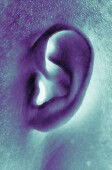
MONDAY, Jan. 18 (HealthDay News) — It takes time, but children who receive cochlear implants in both ears gradually learn to control the loudness and pitch of their voices, a new study has found.
Cochlear implants are electronic devices that provide sound to people who are deaf or severely hearing-impaired.
“Although cochlear implants do not restore sound perception as experienced by an individual with normal hearing, the implant provides the user with auditory feedback in the domains of timing, intensity and frequency of sound. These auditory feedback cues may be critical for the user to monitor his or her speech production and to make purposeful moment-to-moment adjustments in voicing,” wrote Dr. Theresa Holler and colleagues at the Hospital for Sick Children in Toronto, Canada.
The researchers conducted voice assessments of 27 children, aged 3 to 15, who received cochlear implants in both ears. They were compared to children with normal hearing.
Initially, the children with cochlear implants had poor control over the pitch and volume of their voices, compared to children with normal hearing. But voice pitch control improved over the long term as the children with cochlear implants used their hearing aids and had more exposure to hearing.
“To our knowledge, this is the first study to objectively evaluate acoustic voice outcomes in children with bilateral cochlear implants and to report the influence of overall time in sound on acoustic parameters,” the researchers wrote.
“Targeted speech therapies that assist children using cochlear implants in monitoring and modifying the pitch and loudness of their voice would be useful in this setting,” they concluded. “Future work is planned to develop and evaluate therapeutic tools that will specifically address these areas in implant recipients, with the objective of minimizing or eliminating these voice abnormalities.”
The study appears in the January issue of the journal Archives of Otolaryngology — Head & Neck Surgery.
Another paper in the same issue of the journal associated trauma to the ear area and inner ear malformation with some complications that occur in children who receive cochlear implants.
The study included 434 children in France who were followed for an average of 5.5 years after they underwent cochlear implantation. Complications were classified as early (within eight days after surgery) or delayed (more than eight days after surgery), and minor or major (requiring hospital re-admission and/or extended hospital stay).
Forty-three patients (9.9 percent) experienced complications, including 28 with delayed complications, with an average delay of 2.2 years. Of those 43 patients, 13 (30.2 percent) required cochlear re-implantation.
The study also found that 24 patients (5.5 percent) had major complications, including severe infections (15 cases), displacement of the cochlear implant magnet (three cases), meningitis (two cases), skin cyst in the middle ear (two cases), cerebrospinal fluid leak (one case), and misplacement of the cochlear implant electrode (one case).
In addition, 19 patients (4.4 percent) experienced minor complications, including vertigo (nine patients), soft-tissue infections (five patients), persistent inflammation of the middle ear (four patients), and facial paralysis (one patient).
“Trauma to the mastoid [bony projection behind the ear] area (14 patients) and inner ear malformations (51) were highly correlated with major delayed complications and early minor complications, respectively. Young age at cochlear implantation was not correlated with any type of complication,” wrote Dr. Natalie Loundon and colleagues.
They said their results show that complications associated with cochlear implants are not rare and often occur years later, which “highlights the need for long-term medical follow-up in this population and the importance of repeatedly providing information to the patients and their family.”
More information
The U.S. Food and Drug Administration has more about cochlear implants.

